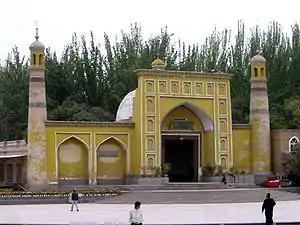Id Kah Mosque
The Id Kah Mosque (Uighur: ھېيتگاھ مەسچىتى, romanized: Hëytgah Meschiti; Chinese: 艾提尕尔清真寺; pinyin: Ài Tí Gǎ Ěr Qīng Zhēn Sì; from Persian: عیدگاه, Eidgāh, meaning "Place of Festivities") is a mosque located in Kashgar, Xinjiang, China.
| مسجد عيدگاه Id Kah Mosque | |
|---|---|
艾提尕尔清真寺 Ài Tí Gǎ Ěr Qīng Zhēn Sì | |
 | |
| Religion | |
| Affiliation | Islam |
| Province | Xinjiang |
| Ecclesiastical or organizational status | Mosque |
| Location | |
| Location | Kashgar, Xinjiang, China |
 Shown within China | |
| Geographic coordinates | 39°28′20″N 75°59′03″E |
| Architecture | |
| Architect(s) | Saqsiz Mirza |
| Type | Mosque |
| Completed | 1442 |
| Specifications | |
| Capacity | 20,000 |
| Minaret(s) | 3 |
| Id Kah Mosque | |||||||
|---|---|---|---|---|---|---|---|
| Chinese name | |||||||
| Simplified Chinese | 艾提尕尔清真寺 | ||||||
| Traditional Chinese | 艾提尕爾清真寺 | ||||||
| |||||||
| Uyghur name | |||||||
| Uyghur | ھېيتگاھ مەسچىتى | ||||||
| |||||||
History
Id Kah is the largest mosque in Xinjiang and is one of the biggest in China. Every Friday, it houses nearly 10,000 worshippers and may accommodate up to 20,000.[1][2]
The mosque was built by Saqsiz Mirza, the elder of two sons of Amir Sayyid Ali, in ca. 1442 (although it incorporated older structures dating back to 996) to commemorate his ancestors and covers 16,800 square meters.
The mosque's modern golden-brick structure was built in 1798 and was further expanded in 1832 to its current size.[3]
On 9 August 1933, Chinese Muslim General Ma Zhancang killed and beheaded the Uyghur leader Timur Beg, displaying his head on a spike at Id Kah mosque.[4][5][6][7]
In March 1934, it was reported that the Uyghur emir Abdullah Bughra was also beheaded, the head being displayed at Id Kah mosque.[8][9]
In April 1934, the Chinese Muslim general Ma Zhongying gave a speech at Id Kah Mosque in Kashgar, telling the Uyghurs to be loyal to the Republic of China Kuomintang government of Nanjing.[10][11][12]
On 30 July 2014, the imam of the mosque, hotelier Jume Tahir, was stabbed to death shortly after attending morning prayers.[13][14] His son Mamat Juma is the current imam.
Architecture Features
The Id Kha Mosque is composed of a chapel, a sutra hall, a gate tower and some other auxiliary buildings. The temple gate is made of yellow bricks, the gate is 4.7 meters high, 4.3 meters wide, and the gate building is about 17 meters high. Two 18-meter-high minarets are built asymmetrically on both sides of the gate tower, and a crescent moon stands on the top of the tower. At dawn each day, the Imam in the temple will climb the tower five times and call for Muslims to come and worship. Behind the gate tower is a large arch, with a minaret at the top.[15]
Allegations of religious persecution
Radio Free Asia reported that in 2018, a plaque containing Quranic scriptures, that had long hung outside the front entrance of the mosque, had been removed by authorities to "eliminate Uyghur faith, literary works, and language".[16]
In May 2020, Radio Free Asia again reported on the removal of the plaque.[17] However, in July 2020, the Chinese embassy in the US tweeted a video interview with the imam showing the plaque hanging inside the mosque, claiming that the mosque had been renovated.[18] The imam stated that the plaque had been moved inside to protect it from exposure to the rain and sun.[18][19]
See also
References
- Peter Neville-Hadley. Frommer's China. Frommer's, 2003. ISBN 978-0-7645-6755-1. Page 302.
- "Id Kah Mosque in Kashgar of Xinjiang: History & Opening Hours". www.topchinatravel.com. Retrieved 2020-08-12.
- Steinhardt, Nancy Shatzman (2015). China's Early Mosques. Edinburgh: Edinburgh University Press. p. 268. ISBN 978-0-7486-7041-3.
- S. Frederick Starr (2004). Xinjiang: China's Muslim borderland. M.E. Sharpe. p. 77. ISBN 0-7656-1318-2. Retrieved 2010-06-28.
- James A. Millward (2007). Eurasian crossroads: a history of Xinjiang. Columbia University Press. p. 198. ISBN 978-0-231-13924-3. Retrieved 2010-06-28.
- Andrew D. W. Forbes (1986). Warlords and Muslims in Chinese Central Asia: a political history of Republican Sinkiang 1911–1949. Cambridge, England: CUP Archive. p. 93. ISBN 0-521-25514-7. Retrieved 2010-06-28.
- The British newspaper The Times reported that a turki chief was beheaded on August 25, 1933
- Christian Tyler (2004). Wild West China: the taming of Xinjiang. New Brunswick, New Jersey: Rutgers University Press. p. 116. ISBN 0-8135-3533-6. Retrieved 2010-06-28.
- Andrew D. W. Forbes (1986). Warlords and Muslims in Chinese Central Asia: a political history of Republican Sinkiang 1911–1949. Cambridge, England: CUP Archive. p. 123. ISBN 0-521-25514-7. Retrieved 2010-06-28.
- S. Frederick Starr (2004). Xinjiang: China's Muslim borderland. M.E. Sharpe. p. 79. ISBN 0-7656-1318-2. Retrieved 2010-06-28.
- James A. Millward (2007). Eurasian crossroads: a history of Xinjiang. Columbia University Press. p. 200. ISBN 978-0-231-13924-3. Retrieved 2010-06-28.
- Andrew D. W. Forbes (1986). Warlords and Muslims in Chinese Central Asia: a political history of Republican Sinkiang 1911–1949. Cambridge, England: CUP Archive. p. 124. ISBN 0-521-25514-7. Retrieved 2010-06-28.
- "Xinjiang imam killed after clashes". 31 July 2014. Retrieved 22 August 2018 – via www.bbc.co.uk.
- James T. Areddy (31 July 2014). "State-Appointed Muslim Leader Killed in China". The Wall Street Journal. Retrieved 1 August 2014.
- "Id Kah Mosque, Kashgar, China".
- "Removal of Islamic Motifs Leaves Xinjiang's Id Kah Mosque 'a Shell For Unsuspecting Visitors'". Radio Free Asia. Retrieved 2020-08-12.
- "Removal of Islamic Motifs Leaves Xinjiang's Id Kah Mosque 'a Shell For Unsuspecting Visitors'". Radio Free Asia. Retrieved 2021-01-02.
- "Chinese Embassy in US". Twitter. Retrieved 2020-08-12.
- "Xinjiang imam refutes U.S. rumor on plaque of historic mosque - Xinhua | English.news.cn". www.xinhuanet.com. Retrieved 2021-01-02.
